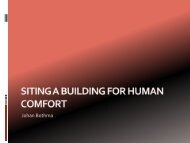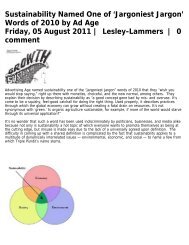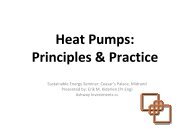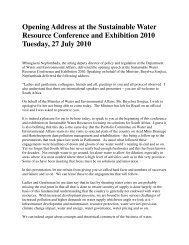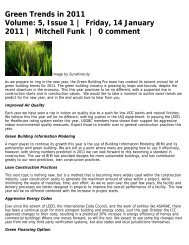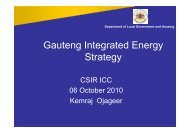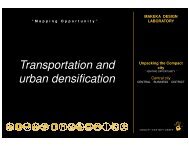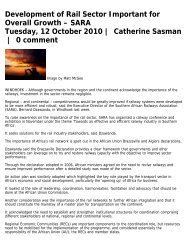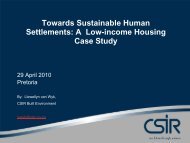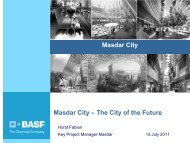Vertical or horizontal separation? - Alive2green
Vertical or horizontal separation? - Alive2green
Vertical or horizontal separation? - Alive2green
You also want an ePaper? Increase the reach of your titles
YUMPU automatically turns print PDFs into web optimized ePapers that Google loves.
<strong>Vertical</strong> <strong>or</strong> h<strong>or</strong>izontal<br />
<strong>separation</strong>?<br />
Rail regulation issues<br />
21 September 2011
Introduction<br />
• A number of policy initiatives are currently on the table f<strong>or</strong> the South<br />
African freight rail sect<strong>or</strong>:<br />
– Economic regulat<strong>or</strong><br />
– Introduction of private participation<br />
– Possible <strong>separation</strong> of track from operations<br />
• The choice of structural model f<strong>or</strong> rail has massive implications f<strong>or</strong> the<br />
complexity of economic regulation, and would merit m<strong>or</strong>e discussion<br />
• <strong>Vertical</strong> <strong>separation</strong> of the track from freight operations is not the only<br />
possible solution: h<strong>or</strong>izontal <strong>separation</strong> of freight into a number of<br />
competing, vertically integrated operat<strong>or</strong>s should also be considered<br />
• Ideally all feasible alternatives should be considered bef<strong>or</strong>e decisions<br />
are made<br />
2
Contents<br />
Outline of presentation<br />
• Implications of vertical versus h<strong>or</strong>izontal <strong>separation</strong> in rail<br />
• Implications of structural choices f<strong>or</strong> economic regulation task<br />
• Current policy debate<br />
• Conclusions<br />
3
<strong>Vertical</strong> and h<strong>or</strong>izontal <strong>separation</strong>
Competition in netw<strong>or</strong>ks<br />
• Not all markets are created equal<br />
– Competition w<strong>or</strong>ks best when a market can supp<strong>or</strong>t many independent<br />
firms, who can only affect each other by competing f<strong>or</strong> customers<br />
– In netw<strong>or</strong>k economies, firms benefit from large netw<strong>or</strong>k size – the m<strong>or</strong>e<br />
they cooperate, the better<br />
– Conversely, if a very large firm in a netw<strong>or</strong>k economy refuses to cooperate<br />
with others, it can drive everyone else out of business (especially if it is<br />
either not possible to replicate the netw<strong>or</strong>k, <strong>or</strong> would be prohibitively<br />
expensive)<br />
• Key problem of netw<strong>or</strong>k economies: how do you ensure that enough<br />
cooperation takes place between firms to supp<strong>or</strong>t market<br />
development, but without stifling competition?<br />
5
Rail as a netw<strong>or</strong>k economy<br />
What characteristics make rail a netw<strong>or</strong>k economy?<br />
• The cost of building a rail netw<strong>or</strong>k is very high in prop<strong>or</strong>tion to the<br />
operating costs per trip<br />
– the m<strong>or</strong>e volume that netw<strong>or</strong>k does, the easier it is to cover the costs of<br />
the initial investment in the track<br />
• The usefulness of the rail netw<strong>or</strong>k to freight customer increases as<br />
interconnectedness increases<br />
– the m<strong>or</strong>e destinations offered, the m<strong>or</strong>e likely customers are to use rail,<br />
and the easier it is to get the volumes necessary to operate profitably<br />
• Everybody who uses a piece of track affects everybody else<br />
– have to co<strong>or</strong>dinate speeds, maintenance, signalling, etc <strong>or</strong> the system<br />
grinds to a halt<br />
• Given these characteristics, running rail as a monopoly makes<br />
intuitive sense<br />
– but the cost is the loss of price and quality competition<br />
6
Why <strong>separation</strong>?<br />
• <strong>Vertical</strong> and h<strong>or</strong>izontal <strong>separation</strong> models both attempt to introduce<br />
competition in rail<br />
– These models arguably decrease the operating efficiency of rail<br />
– Pay-off is the increase in price and quality competition<br />
– But: not certain that this pay-off will materialise if the regulat<strong>or</strong> can’t cope<br />
with the complex regulat<strong>or</strong>y task posed by either f<strong>or</strong>m of <strong>separation</strong><br />
• <strong>Vertical</strong> <strong>separation</strong>: rail track should be housed in a separate<br />
agency. It is a natural monopoly and should be run as a public utility,<br />
possibly on a not-f<strong>or</strong>-profit basis. The job of the track owner is to allow<br />
operat<strong>or</strong>s to compete freely among themselves<br />
• H<strong>or</strong>izontal <strong>separation</strong>: each operat<strong>or</strong> owns its own track and rolling<br />
stock, but is restricted to a given geographical area, and competes<br />
with other integrated operat<strong>or</strong>s<br />
• Which produces the best result?<br />
7
<strong>Vertical</strong> <strong>separation</strong><br />
• The goal of vertical <strong>separation</strong> is to level the playing field between<br />
competing rail operat<strong>or</strong>s<br />
– All operat<strong>or</strong>s face the same cost structure in using the netw<strong>or</strong>k<br />
– Customers can ideally then choose between different operat<strong>or</strong>s f<strong>or</strong> the<br />
same service, on the same track – enables competition<br />
– Because all netw<strong>or</strong>k facilities are shared, no single operat<strong>or</strong> has the ability<br />
to deny a competit<strong>or</strong> access<br />
• This model has been used f<strong>or</strong> freight rail in a number of countries,<br />
including the United Kingdom and the European Union<br />
8
Substantial practical costs<br />
<strong>Vertical</strong> <strong>separation</strong> & efficiency<br />
• Some studies have suggested that the reduction in technical<br />
efficiency associated with vertical <strong>separation</strong> can be in the region of<br />
20-40% (Ivaldi & McCullough 2004, 16)<br />
• Technical efficiency issues have a number of sources:<br />
– Money spent on maintaining rolling stock helps to reduce damage to the<br />
track and vice versa: separating ownership means both parties have an<br />
incentive to under-invest in maintenance<br />
– Scheduling and co<strong>or</strong>dination affects efficiency – m<strong>or</strong>e difficult to<br />
accomplish with multiple operat<strong>or</strong>s<br />
– May create sequential monopolies anyway – single operat<strong>or</strong>s on certain<br />
c<strong>or</strong>rid<strong>or</strong>s<br />
• Determining appropriate access fees and allocating scarce access to<br />
track are also complex tasks f<strong>or</strong> the track owner<br />
• Potential f<strong>or</strong> damaging favouritism<br />
9
H<strong>or</strong>izontal <strong>separation</strong><br />
• Under h<strong>or</strong>izontal <strong>separation</strong>, each area is covered by only one<br />
operat<strong>or</strong> – establishes regional monopoly providers, with integrated<br />
above track/below track activities<br />
• However, some competitive constraints remain:<br />
– Competition f<strong>or</strong> concessions can be used to constrain pricing behaviour<br />
over the term of the concession<br />
– Competition to service key geographical destinations may be possible,<br />
depending on geography<br />
• The interchange points between different vertically integrated<br />
operat<strong>or</strong>s become the focus of regulat<strong>or</strong>y attention<br />
• Countries using some f<strong>or</strong>m of h<strong>or</strong>izontal <strong>separation</strong> in freight rail<br />
include the United States, Canada and Mexico<br />
10
Geography is probably key<br />
H<strong>or</strong>izontal <strong>separation</strong> & efficiency<br />
• H<strong>or</strong>izontally separated operat<strong>or</strong>s are appropriately incentivised to<br />
invest in optimal maintenance levels – efficiency improving<br />
• Counter-balanced if the freight geography lends itself to bottlenecks<br />
and natural monopolies<br />
• Mexican example:<br />
– Mexico City is a key freight destination<br />
– It is landlocked and served by several rail freight c<strong>or</strong>rid<strong>or</strong>s linked to<br />
different p<strong>or</strong>ts<br />
– Only area of shared track infrastructure is directly around Mexico City –<br />
limits regulat<strong>or</strong>y burden<br />
– H<strong>or</strong>izontal <strong>separation</strong> is able to generate substantial competition f<strong>or</strong> freight<br />
• Geographical similarities to Johannesburg?<br />
11
H<strong>or</strong>izontal competit<strong>or</strong>s?<br />
12
Market structure and regulation
When to regulate?<br />
• Economic regulation is difficult to do, and even m<strong>or</strong>e difficult to do<br />
well<br />
– Requires intrusion into private business affairs that may be legally<br />
contested: needs excellent legal framew<strong>or</strong>k and skill set to implement<br />
– Requires en<strong>or</strong>mous amounts of data and highly skilled interpretation of that<br />
data to set prices and prevent anti-competitive behaviour<br />
– Needs to be done continuously<br />
• Logical implication: you only regulate when you absolutely have to<br />
– Market failure which resists structural solutions<br />
– Potential pay-off from regulation sufficient to compensate f<strong>or</strong> costs of<br />
regulation<br />
– Intermodal competition insufficient to restrain prices<br />
• Regulation should resolve market logjams and enable competition as<br />
much as possible<br />
14
<strong>Vertical</strong> vs h<strong>or</strong>izontal <strong>separation</strong><br />
Choice should be influenced by the<strong>or</strong>y and facts on the ground<br />
• Economic regulation is critical f<strong>or</strong> the success of both vertical and<br />
h<strong>or</strong>izontal <strong>separation</strong><br />
• Size of the regulat<strong>or</strong>y task depends on the characteristics of the<br />
netw<strong>or</strong>k concerned<br />
– Do geographical conditions enable competition between vertically<br />
integrated operat<strong>or</strong>s?<br />
– Is there sufficient scale on existing c<strong>or</strong>rid<strong>or</strong>s to ensure the viability of<br />
competing vertically separated operat<strong>or</strong>s?<br />
– Is there a hist<strong>or</strong>ical relationship between the track and a given operat<strong>or</strong>,<br />
which would lead to favouritism issues under vertical <strong>separation</strong>?<br />
– Would h<strong>or</strong>izontally separated operat<strong>or</strong>s need substantial access to other<br />
netw<strong>or</strong>ks to effectively compete? (which would require an additional access<br />
pricing regime – compuls<strong>or</strong>y trackage rights)<br />
15
Devil is in the details<br />
Policy intentions can be derailed by implementation choices<br />
• The establishment of an economic regulat<strong>or</strong> is not a cure-all – scope<br />
of regulat<strong>or</strong> to improve sect<strong>or</strong> outcomes strongly affected by policy<br />
choices<br />
• F<strong>or</strong> example:<br />
– Does the chosen market structure complicate <strong>or</strong> simplify the regulat<strong>or</strong>y<br />
task?<br />
– Does the regulat<strong>or</strong> have sufficient control of the incumbent to offset its<br />
competitive advantage over new entrants?<br />
– Has the regulat<strong>or</strong> been given sufficient independence?<br />
• The choice of vertical <strong>or</strong> h<strong>or</strong>izontal <strong>separation</strong>, <strong>or</strong> some mixture of the<br />
two, plays a maj<strong>or</strong> role in determining regulat<strong>or</strong>y viability – and thus<br />
the net impact of regulation on market outcomes<br />
16
The South African policy debate
Way f<strong>or</strong>ward not clear<br />
• Limited transparency in the rail policy debate to date:<br />
– National Freight Logistics Strategy 2005 called f<strong>or</strong> limited introduction of<br />
private competition at operat<strong>or</strong> level, with the track infrastructure retained<br />
by the state – implied vertical <strong>separation</strong><br />
– Also commissioning of branch lines – mixed h<strong>or</strong>izontal and vertical<br />
<strong>separation</strong>?<br />
– Concessionaires beginning to complain about lack of access to main lines:<br />
does this imply that a vertical <strong>separation</strong>/track access model is not really on<br />
the cards?<br />
• Transnet has now also declared its opposition to splitting out track<br />
assets and vertical <strong>separation</strong> in general<br />
• Not aware of any publically available w<strong>or</strong>k that has been done on the<br />
trade-off between h<strong>or</strong>izontal and vertical <strong>separation</strong> in South Africa<br />
18
Conclusions
Good policy needs good research<br />
• Something needs to be done to improve rail freight perf<strong>or</strong>mance<br />
• Exactly what that is, is an empirical question, that needs to be<br />
resolved by careful analysis<br />
• Based on what has been released to the public by policymakers in<br />
rail, there is no evidence that this has yet been done<br />
– Some preference seems to be shown f<strong>or</strong> vertical <strong>separation</strong><br />
– Interpretation of vertical <strong>separation</strong> may also have h<strong>or</strong>izontal elements, that<br />
tend to further disadvantage new entrants<br />
– Limited discussion of h<strong>or</strong>izontal <strong>separation</strong> – not clear if it has been<br />
considered and rejected, <strong>or</strong> not evaluated at all<br />
• Would be extremely encouraging to see m<strong>or</strong>e consideration of this<br />
issue going f<strong>or</strong>ward – evidence-based policy making techniques<br />
would be of use, particularly regulat<strong>or</strong>y impact assessment models<br />
20
Tel +27 (0)12 362 0024<br />
Fax +27 (0)12 362 0210<br />
Email contact@dnaeconomics.com<br />
www.dnaeconomics.com<br />
4th Flo<strong>or</strong>, South Office Tower, Hatfield Plaza,<br />
1122 Burnett Street, Hatfield, Pret<strong>or</strong>ia, 0083<br />
PO Box 95838, Waterkloof, 0145<br />
DNA Economics is the registered business and trading name of Development Netw<strong>or</strong>k Africa (Pty) Ltd<br />
Company Registration: 2001/023453/07│Direct<strong>or</strong>s: Elias Masilela │Matthew Stern



